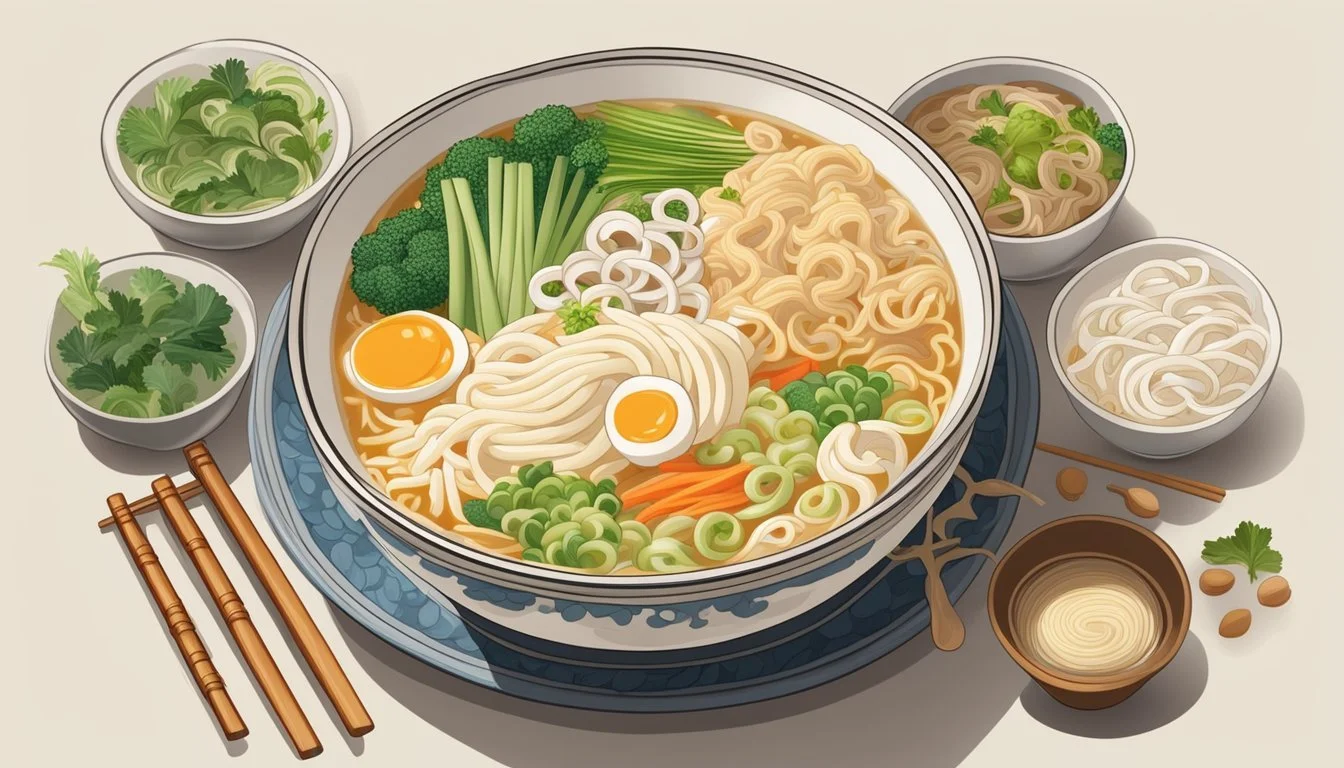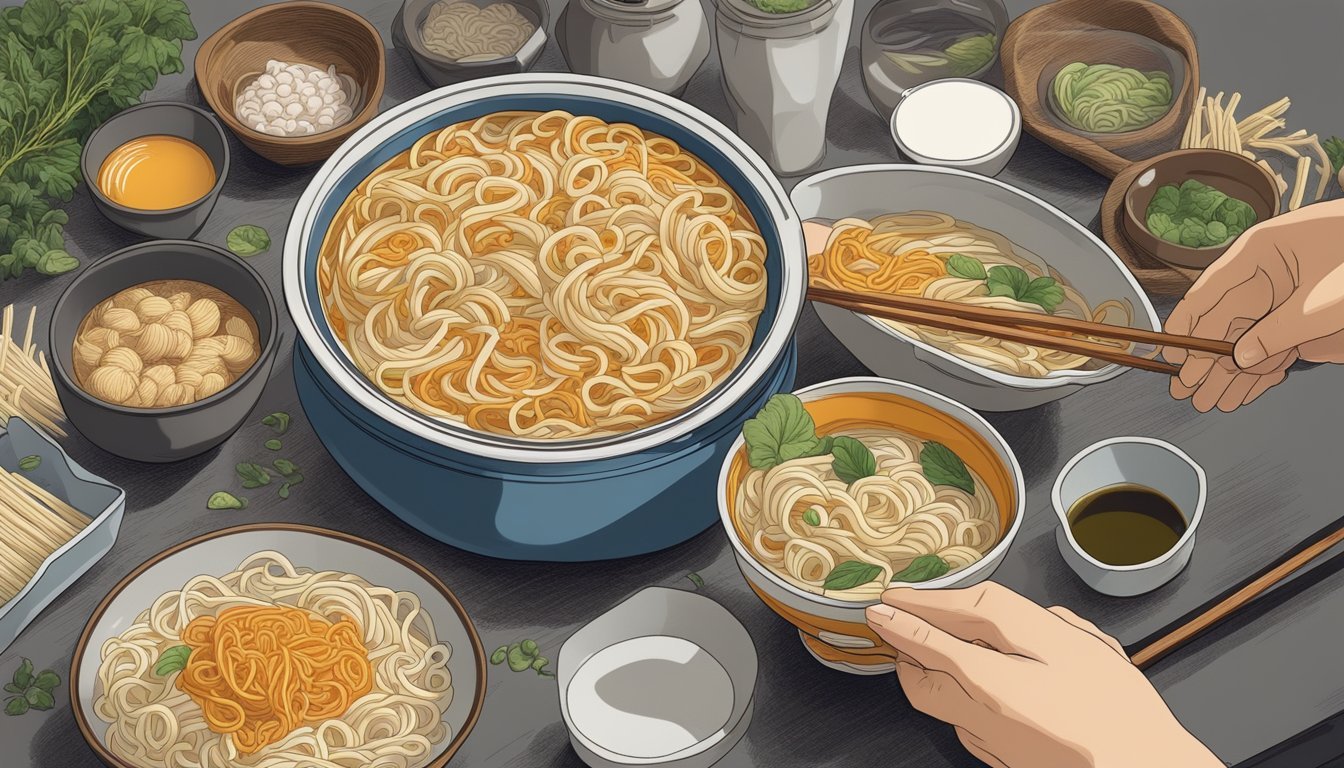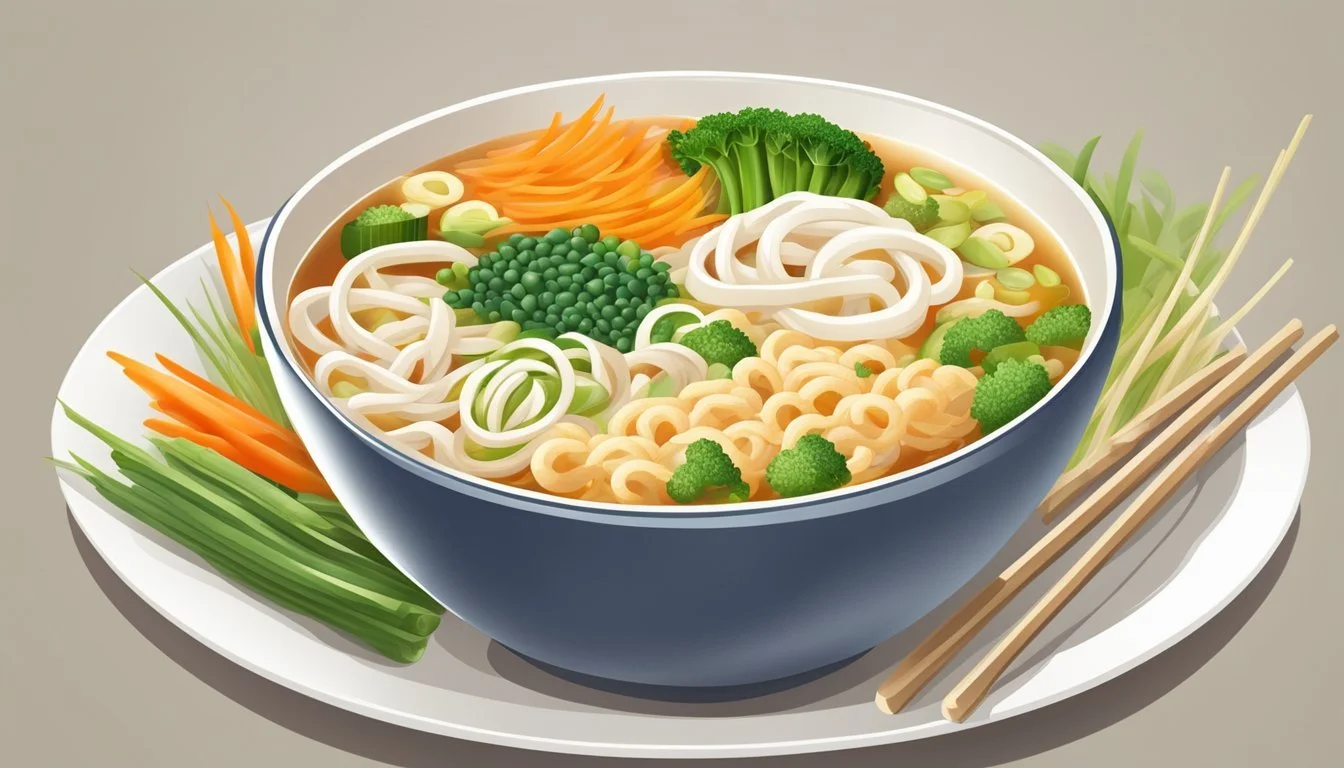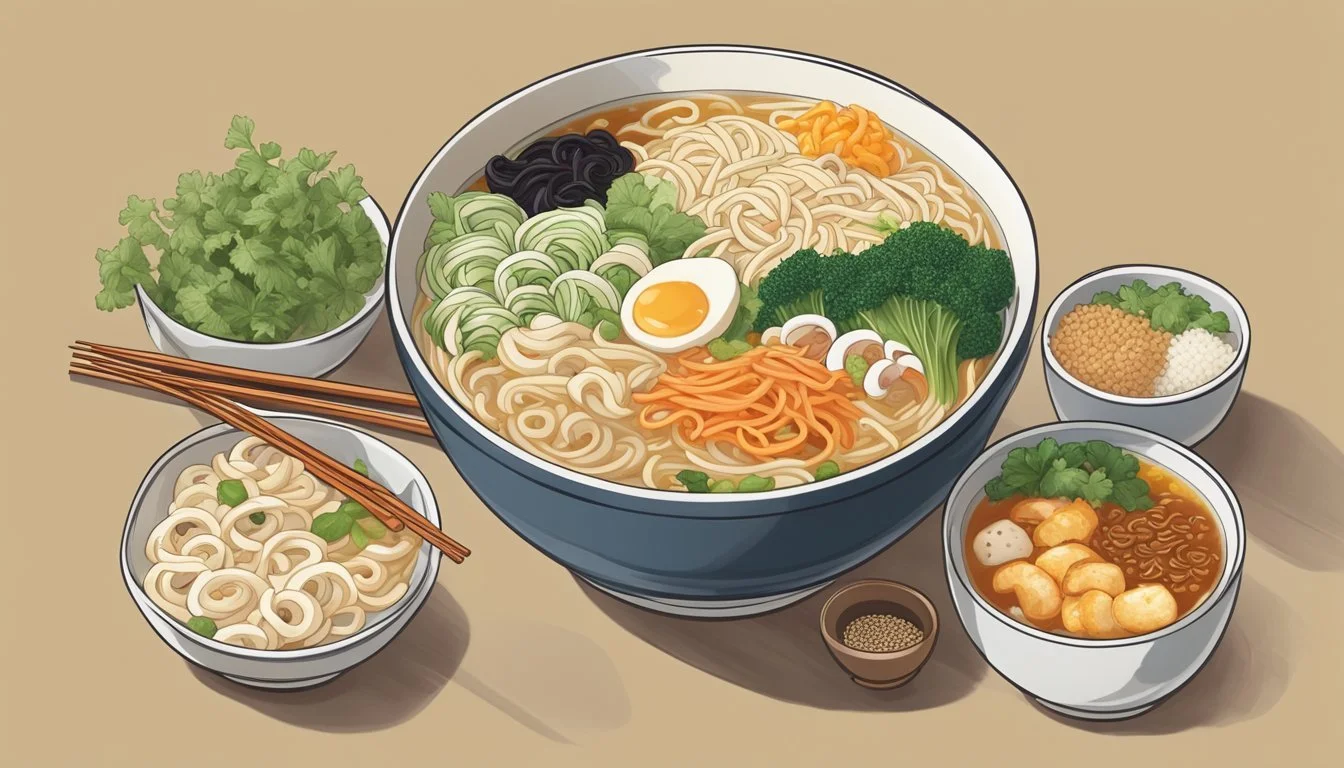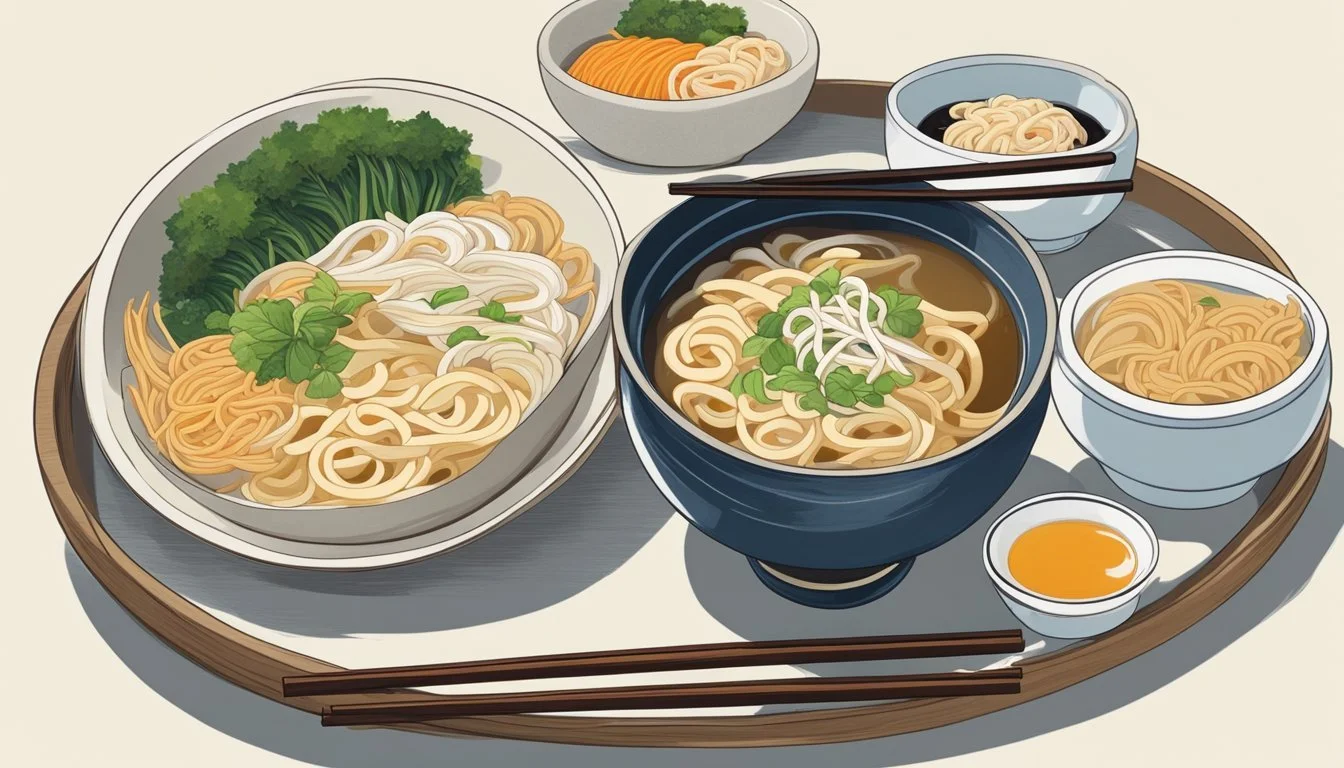How to Substitute Udon for Ramen in Soup Recipes
Expert Tips for a Seamless Swap
Udon noodles are a versatile ingredient commonly found in Japanese cuisine, thick and chewy with a neutral flavor that makes them an excellent candidate for various dishes, including soups (What wine goes well with soups?). While typically used in their own specific type of soup, these noodles can be effortlessly swapped for ramen noodles in various recipes. Due to the similar base ingredients of wheat flour, water, and salt, udon provides a similar consistency and taste that complements the rich broths of ramen dishes.
When substituting udon for ramen, it's important to consider the differences in cooking times and noodle texture. Udon noodles are thicker than ramen and can bring a different mouthfeel to the soup, providing a more substantial bite. This difference in texture is something to keep in mind when crafting a soup meant to mimic the traditional ramen experience. However, the substitution is straightforward and can yield satisfying results, especially for those looking to experiment with their soup recipes or seeking a gluten alternative commonly found in ramen noodles.
Understanding Udon and Ramen Noodles
When substituting udon for ramen in soup recipes, it's important to appreciate the distinct characteristics of each noodle type, which include their unique textures and ingredients. Both noodles are central to Japanese cuisine but offer different culinary experiences.
Characterizing Udon Noodles
Udon noodles are thick, white noodles made from wheat flour, water, and salt. They distinguish themselves by their chewy and soft texture. In culinary use, they absorb flavors well but tend to provide a more subdued backdrop to soups and dishes. Udon's texture is often described as pillowy or silky, providing a satisfying mouthfeel.
Composition: Wheat flour, salt, water
Texture: Thick, chewy, soft
Characterizing Ramen Noodles
Ramen noodles, another staple of Japanese noodle dishes, are also made from wheat flour. However, they include a specific ingredient called kansui (alkaline water), which gives them a firm, elastic texture and a yellow hue. They can vary in thickness and shape but are generally thinner and firmer than udon noodles. Ramen often features the additional component of egg, which contributes to its distinctive texture and nutritional content, often increasing the protein content.
Composition: Wheat flour, salt, water, kansui, sometimes egg
Texture: Elastic, firm
Comparing Udon and Ramen Textures
The textual contrast between udon and ramen noodles plays a crucial role in Japanese soup dishes. Udon has a markedly thicker and softer texture, typically suited for lighter broths that don't overshadow the noodle's subtlety. Conversely, ramen noodles possess an elastic and chewy character that stands up to the rich, often meaty broths associated with ramen dishes. This resilience makes ramen noodles adept at absorbing bold flavors without losing their textural integrity.
Udon: Thicker, absorbs light flavors, suited to light broths
Ramen: Thinner, absorbs bold flavors, suited to rich broths
Selecting Broth for Udon Substitution
When substituting udon with ramen in soup recipes, one must consider the broth's composition carefully to maintain the integrity of the dish's flavor.
Identifying Ideal Broth Types
For traditional Japanese dishes that typically use udon, dashi is the quintessential broth. It offers a delicate umami flavor which complements the thicker, chewier texture of udon noodles. When replacing udon with ramen, one should seek a broth that closely mimics this taste profile. Chicken broth can serve as a robust foundation, particularly for non-vegan options. It's light enough to not overpower the mild taste of ramen noodles while providing sufficient depth. For a vegan alternative, vegetable broths, especially those with a shiitake mushroom base, are recommended due to their savory qualities.
Adjusting Broth Flavor Profiles
Adjusting the flavor profile of the broth to suit ramen noodles involves considerations of both strength and seasoning.
Beef broth, with its hearty and rich flavor, might be too overpowering for ramen noodles. If using beef broth, one may need to dilute it with water or a vegetable broth to achieve a lighter taste.
In contrast, chicken broth can be enhanced with soy sauce, mirin, or a dash of sake to add complexity without overwhelming the ramen.
For vegan dishes, one may bolster the broth with kombu or dried seaweed to intensify umami notes that otherwise might be provided by fish flakes in dashi.
By carefully choosing and modifying your broth, one ensures the substituted ramen noodles can be as delicious as the udon they replace.
Preparing Udon Noodles
Proper preparation of udon noodles is essential for achieving the right texture and flavor when substituting them in ramen recipes. This section outlines cooking techniques for udon, offers guidance on customizing their texture, and provides a basic method for making homemade udon noodles.
Cooking Techniques for Udon
To cook udon noodles, one should start by bringing a large pot of water to a rolling boil. It is crucial to ensure the water volume is sufficient to give the noodles enough space to move freely. Typically, for 200 grams of udon, one would use about 2 liters of water. Once boiling, the udon should be added and stirred gently to prevent sticking. Cooking times vary depending on whether the udon are dry or fresh:
Dry udon typically requires 8-10 minutes.
Fresh udon may only need 2-3 minutes.
The key is to taste the noodles during the cooking process and look for a pleasantly chewy and soft texture, known as 'al dente'.
Customizing Udon Texture
The texture of udon noodles can be modified to suit one's preference. After cooking, rinsing the noodles under cold water stops the cooking process and removes excess starch, which helps them firm up and retain a pleasant bite. For a softer texture, one may skip this step. Additionally, to prevent the noodles from sticking together, they can be lightly tossed in a teaspoon of sesame oil or another preferred oil.
Making Homemade Udon Noodles
Homemade udon noodles offer freshness and a customizable texture. To create the dough for homemade udon, one needs only four basic ingredients:
Wheat flour - The base of the dough, typically all-purpose flour, gives the udon its structure.
Water - Slightly salted water hydrates the flour.
Salt - A dash of salt enhances the dough's flavor.
The dough should be kneaded until smooth and then allowed to rest. After resting, the dough is rolled out and cut into thick strands. Freshly cut udon noodles should be cooked in boiling water for about 10 minutes, checking periodically for the desired 'al dente' texture.
Adapting Recipes with Udon
When substituting udon for ramen in soup recipes, one should be aware of the textural differences between the noodles and the need for potential adjustments in flavor and seasoning to complement the thicker, chewier udon noodles.
Modifying Ramen Recipes for Udon
Ramen recipes typically call for thin, wheat-based noodles served in a broth seasoned with soy sauce, mirin, and various other flavorings. Udon, being thicker and more absorbent, requires a longer cooking time and may result in a slightly altered texture in the final dish. Cooks should follow these guidelines when adapting a ramen recipe for udon:
Cook Time: Increase the boiling time for udon, as they are thicker.
Noodle to Broth Ratio: Consider using more broth or less udon to avoid a disproportionate noodle-to-liquid balance.
Additives: Introduce vegetables or proteins tailored to the heft of udon, such as thicker slices of meat or larger vegetable pieces.
Balancing Flavors and Seasonings
Ramen broth is often a complex blend of tastes, primarily dominated by a balance of saltiness, umami, and a hint of sweetness. With the introduction of udon noodles, the flavor profile of the soup can be affected due to udon's ability to absorb seasonings. Take note of the following to maintain a harmonious flavor:
Soy Sauce: Udon may require a reduction in soy sauce to avoid excessive saltiness.
Mirin: The mild sweetness of mirin can help offset the salt, but adjust carefully to maintain the desired flavor.
Sodium Levels: Check the overall sodium content when using udon, as these noodles can contribute to a saltier soup.
Amplify Umami: Incorporate ingredients like seaweed or mushrooms to enhance umami without adding extra sodium.
Incorporating Proteins and Vegetables
When substituting udon for ramen in soup recipes, it is important to consider the balance and integration of proteins and vegetables. They not only add nutritional value but also contribute to the overall flavor and texture of the dish.
Choosing Proteins for Udon Soup
Proteins are essential in creating a satisfying udon soup. One can choose from various options such as chicken, beef, tofu, shrimp, or fish. Each protein should be prepared appropriately to ensure it complements the udon noodles' thicker texture.
Chicken: Slice thinly and simmer until fully cooked.
Beef: Opt for quick-cooking cuts like sirloin, thinly sliced against the grain.
Tofu: Use firm or extra-firm tofu, cut into cubes, and lightly fried or poached.
Shrimp: Shell and devein the shrimp; they will cook quickly in the hot broth.
Fish: Select firm, white-fleshed fish, cut into bite-sized pieces, and gently simmered.
Selecting and Preparing Vegetables
The vegetables in udon soup should provide a mix of textures and tastes, enhancing the broth and interacting well with the chewiness of the noodles.
Green onion: Slice thinly and add towards the end of cooking for a fresh, sharp flavor.
Mushrooms: Varieties like Shiitake or button mushrooms should be sliced and sautéed to bring out their earthy taste.
Spinach: Rinse thoroughly and add at the last minute; it wilts quickly in hot soup.
Carrots: Julienne or slice thinly to ensure they cook rapidly.
For a balanced dish, aim for a variety of colors and nutrient profiles. Sauteing heartier vegetables first will develop their flavors before combining them with the rest of the soup ingredients. Delicate items like spinach should be added just before serving to retain color and nutrients.
Topping and Garnishing
When substituting udon for ramen in soup recipes, one should pay special attention to the toppings and garnishes used to complement the thicker texture and milder flavor of udon noodles.
Selecting Toppings for Udon
For udon noodle soup, it is essential to select toppings that balance well with its heartier, chewier texture. Common toppings include:
Green Onions: Finely chopped green onions add a fresh, sharp taste that contrasts nicely with the mildness of udon.
Kamaboko: This steamed fish cake, with its distinctive pink swirl, is a classic udon topping that contributes both color and a subtle seafood flavor.
Tempura: Crispy tempura, such as shrimp or vegetables, provides a textural contrast to the soft noodles.
Katsuobushi: These are shaved bonito flakes that offer a smoky, umami-rich accent to the dish.
A well-judged selection of toppings can elevate the dish, providing a mix of textures and flavors that complement the udon.
Garnishing for Flavor and Presentation
Garnishing udon soup not only enhances the flavor but also the visual appeal of the dish. Here are a few garnishes to consider:
Nori: Strips of nori (dried seaweed) can be placed atop the soup for a marine hint that complements any seafood elements in the dish.
Scallions: Similar to green onions, scallions can be used as a garnish, offering a milder onion flavor along with a bright pop of green.
Shichimi Togarashi: A sprinkle of this seven-flavor chili pepper adds a spicy complexity that can liven up a milder udon soup.
Garnishes should be applied with a measured hand to ensure they enhance rather than overpower the inherent flavors of the udon soup.
Considering Dietary and Health Aspects
When substituting udon for ramen in soup recipes, it is important to consider how this swap may affect the dietary and health profile of the dish, particularly in terms of fiber content, carbohydrate levels, and suitability for various dietary restrictions.
Exploring Healthier Recipe Variations
Udon noodles generally offer a nutritious alternative to ramen, as they are made from wheat flour, water, and salt. Unlike some ramen noodles, they do not typically include egg, making them suitable for those following a vegan diet. To create a healthier dish, chefs may opt for whole grain udon noodles, which provide a higher fiber content beneficial for digestion and overall health. In Japanese cuisine, these heartier noodles contribute not only to a dish's nutritional value but also to its traditional texture and taste.
For individuals looking for a low-carb option, udon may not be the ideal substitute due to its similar wheat-based composition. Instead, they may consider other Japanese noodles such as shirataki, made from konjac yam, which is significantly lower in carbohydrates.
Addressing Dietary Restrictions
Gluten-free: While udon and ramen noodles are traditionally made with wheat, it is crucial to provide alternatives for those with gluten sensitivities. Gluten-free substitutes such as rice noodles or buckwheat-based soba noodles can be excellent choices for maintaining the integrity of the dish while adhering to dietary restrictions.
Vegan: Both udon and ramen noodles can align with a vegan diet, though one must ensure that no eggs are used in their production. Udon noodles often fit this requirement inherently, though as with any ingredient, it's important to check individual product labels for confirmation.
Through careful selection of noodles and mindful consideration of their ingredients, one can successfully cater to a variety of dietary needs while preserving the authenticity and nutritional value of a classic Japanese noodle soup.
Alternative Noodle Substitutions
When substituting udon with ramen in soup recipes, the texture and flavor of the noodles are pivotal. Different noodle substitutions offer varied experiences, tailored to specific dietary needs and flavor profiles.
Using Soba and Buckwheat Noodles
Soba noodles, crafted from buckwheat flour, are a robust option with a nutty flavor. They maintain a firm texture that mimics the bite of udon, making them suitable for soupy dishes. However, one needs to be cautious as some soba noodles contain a blend of wheat and buckwheat, affecting those with gluten sensitivities.
Substitute Options for Gluten-Free Diets
For gluten-free diets, several alternatives exist:
Rice Noodles: These come in various thicknesses and are versatile. Their neutral taste allows them to take on the rich flavors of the soup.
Glass Noodles: Made from mung bean starch, they are translucent with a slippery texture, which can closely resemble the satisfaction of slurping up udon.
Veggie Noodles: Options like spiralized zucchini or carrots provide a nutritious twist while being naturally gluten-free.
Kelp Noodles: They are clear, made from seaweed, and offer a unique, crunchy texture to your ramen soup without the gluten.
Each alternative offers a distinctive texture and taste quality, allowing a personalized culinary experience in finding the perfect udon substitute for your soup recipe.
Cultural Context of Udon Soup
In exploring the cultural significance of udon soup within Japanese cuisine, one will find that it holds a historical place in Japanese culinary traditions. This section breaks down the cultural background of udon soup, focusing on its role in Japanese cuisine and how it transcends just being a soup.
Understanding Udon in Japanese Cuisine
Udon is a type of Japanese noodle that is thick, chewy, and made from wheat flour. It has been a staple in Japanese diet for centuries. There are different styles of udon, such as Sanuki udon, known for its firm texture and square shape, which hails from the Kagawa prefecture of Japan. Kake udon, a simple udon soup made with these noodles, consists of a hot broth called kakejiru, which is based on dashi, soy sauce, and mirin, and is often garnished with thinly sliced scallions.
The act of eating udon soup is also culturally significant. The slurping sound when consuming the noodles is not rude but rather considered a sign of enjoying the meal and is acceptable in Japanese dining etiquette.
Enjoying Udon Beyond Soups
Udon's versatility extends beyond soups into other dishes. Yaki udon is a popular variation where the noodles are stir-fried with soy-based sauce and a variety of meats and vegetables. This dish is proof of the noodle's adaptability across different preparation methods within Japanese cuisine.
Despite its roots in traditional Japanese foods, (What wine goes well with Japanese food?) udon has gained international recognition and can be found in many fusion and contemporary dishes around the world. Chefs have taken to its neutral flavor and satisfying texture to craft innovative recipes that pay homage to its origin while delivering new experiences to diners.


